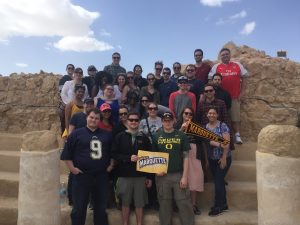 From student J.J. Moore, here is a reflection on how the story that is told depends on the storyteller.
From student J.J. Moore, here is a reflection on how the story that is told depends on the storyteller.
I have always loved ruins. Ruins tell a story and bring an appreciation of the past. However, a forgotten aspect of ruins is the stories that surround them. The combination of beauty and history converge at the ruins of Masada. The utter beauty of the sight, whether it was the preserved ruins or the breathtaking views atop the rock cliff, brought me to a place of deep peace.
Let me provide a brief (Roman) summary of the siege of Masada. Following the destruction of the Jerusalem Temple, roughly in 70 BCE, a small band of Jewish zealots maintained a stronghold atop the rock cliffs. The Romans surrounded Masada setting up camps, which are still preserved today, and built a siege ramp to break into the fortress. When the Jewish rebels realized that they would not be able to hold off any longer, they killed their families, and since Judaism prohibits suicide, drew lots to determine the final man to commit suicide. Additionally, the men destroyed everything except the food supplies to show the Romans that they could have withheld, but decided to choose death over slavery.
History is written by the victors, and Flavius Josephus was the only historian to detail the account of the siege of Masada. As with any story, there might be exaggerations or altering of the details. But, over time, more questions have been raised about this version. One such question concerns the detail that the Romans broke the barrier at night and then supposedly returned back to camp to get a good night’s sleep before attacking Masada in the morning. Yet attacking Masada as the sun would have been in their eyes seems illogical. Furthermore, the Romans were known to be ruthless, and when has another Roman story appeared where the soldiers would not take a kill-shot when it was present? Instead, it is quite possible that the Romans did not want to be seen as barbarians by slaughtering rebels (including women and children) that may have wished to surrender when victory was no longer an option. Flavius’s version seems uplifting and positive, but also shows the Romans in a bright light since their siege forced the rebels to resort to killing each other as the Romans approached.
This made me think that there are always more sides to a story than the one being presented. As an aspiring attorney, I may work with the story that is given, but I should not take it as the only story. Whether it is in a mediation, negotiation, or arbitration, the stories being told are from the perspective and benefit of the side talking, so it might be my job to weed out the facts and be willing to question the statements to find the context. In conclusion, with the stories we tell, there are seeds of truth mixed in with fertilizers of embellishment.
[Cross-posted at Indisputably.]
